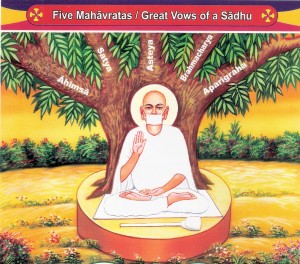
Credit: Wikipedia
For most of us, learning to embrace death is the most difficult challenge of our lives. We all die, whether we want to or not. Many of us may find out more about ourselves in our final moments than we thought we knew for the entire duration of our lives. Thus enters the Jain practice of the spiritual fast to the death. It is most popularly known as Santhara or Sallekhana, although it is also known as Samadhi-marana and Samnyasa-marana. Regardless of what it is called, the practice remains the same: it is a fast that a Jain may take at the end of his life to purge old karmas as he transitions into the next life.
Although the practice seems simple, for those that undergo Santhara, it may be the most difficult trial of their lives. When a Jain feels that she has entered the final stage of her life, she may ask permission of her friends, her family and her guru for their blessing before she is even allowed to practice Santhara. This is the most important step: Jains are only sanctioned to practice Santhara when they are at the end of their lives, in good mental and emotional health and when they no longer have any meaningful work left to complete in their lives.
Although the practice seems simple, for those that undergo Santhara, it may be the most difficult trial of their lives.

Credit: Wikipedia
If the vow of Santhara has been approved, then the Jain is permitted to gradually give up food and liquids as he nears the end of his life. During this time, he must make peace with death as he learns to give up all worldly attachments and let go of any emotions that serve as attachments to his current life. If he cannot let go of these worldly attachments, then he has failed in his vow and he must stop practicing Santhara and give up the fast.
Controversy surrounds Santhara in the modern era. While some see it as an overwhelmingly spiritual vow, others have argued that the practice is nothing more than a suicide that elderly Jains are pressured into performing. But for practicing Jains, this cannot be further from the truth. After all, Santhara can only be practiced by Jains that are already near death. Whether it is through terminal illness or just old age, Santhara is a means of finding a peace of mind that transcends death and illness. Unlike suicide, the process of Santhara is incredibly slow and it requires an intense thoughtfulness on relinquishing hold on your place in life and the unanimous support from loved ones. It is not a selfish act, as many consider suicide to be, and completing Santhara successfully requires an incredible strength of will that many would argue is just not present among most suicide victims.
Whether it is through terminal illness or just old age, Santhara is a means of finding a peace of mind that transcends death and illness.

Credit: Wikipedia
Despite the controversy, Santhara continues to be an idealized way to embrace death that has been practiced for over 2,000 years. Each year, hundreds of Jains seek to achieve enlightenment by taking the vow. The practice itself is indiscriminately popular among monks and common practitioners alike. Although Santhara may seem strange to an American audience, it is hard to ignore the profound effect that it has had on so many people. As for me, aside from the hearty length of time it takes, the strict meditation requirements, and the noticeable absence of pain medication, Santhara sees to vaguely resemble our own hospice practices. As nutrition is withheld from our loved ones, we too gather together to say farewell as pain medications like morphine gently guides them to the end of their life.
Related SevenPonds Articles:
• The End-of-Life and Death in India
• Bizarre Death Ritual: 19th Century Buddhist Self-Mummification
• In Living Color: India’s Holi Festival

 Embracing Death with the Jain Ritual of Santhara
Embracing Death with the Jain Ritual of Santhara


 First the Wealth Gap, Now the U.S. Has a Growing Health Gap
First the Wealth Gap, Now the U.S. Has a Growing Health Gap
 How to Comfort A Dying Loved One
How to Comfort A Dying Loved One
 Our Annual Seven Holiday Gifts for Someone Who Is Grieving, 2024 Edition
Our Annual Seven Holiday Gifts for Someone Who Is Grieving, 2024 Edition














